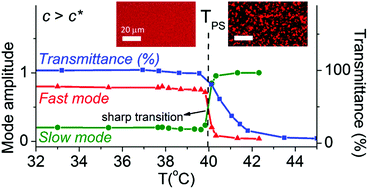当前位置:
X-MOL 学术
›
Soft Matter
›
论文详情
Our official English website, www.x-mol.net, welcomes your feedback! (Note: you will need to create a separate account there.)
Optical tracking of relaxation dynamics in semi-dilute hydroxypropylcellulose solutions as a precise phase transition probe
Soft Matter ( IF 3.4 ) Pub Date : 2017-09-13 00:00:00 , DOI: 10.1039/c7sm01501a Hernan Garate 1, 2, 3, 4, 5 , King-Wo Li 6, 7, 8, 9, 10 , Denis Bouyer 6, 7, 8, 9, 10 , Patrick Guenoun 1, 2, 3, 4, 5
Soft Matter ( IF 3.4 ) Pub Date : 2017-09-13 00:00:00 , DOI: 10.1039/c7sm01501a Hernan Garate 1, 2, 3, 4, 5 , King-Wo Li 6, 7, 8, 9, 10 , Denis Bouyer 6, 7, 8, 9, 10 , Patrick Guenoun 1, 2, 3, 4, 5
Affiliation

|
Phase separation of thermo-responsive polymers in solution is a complex process, whose understanding is essential to screen and design materials with diverse technological applications. Here we report on a method based on dynamic light scattering (DLS) experiments to investigate the phase separation of thermo-responsive polymer solutions and precisely define the transition temperature (TPS). Our results are applied on hydroxypropylcellulose (HPC) solutions as an important biosourced green water-soluble polymer. As determined by DLS, the amplitudes of the fast and slow modes of relaxation dynamics evolve as temperature gets closer to the phase transition point eventually leading to phase separation. The evolution of relaxation modes with temperature is markedly different for concentrations below the overlap concentration (c*) (dilute regime), above c* (semi-dilute regime) and above the entanglement concentration (ce). In the three cases though, the fast and slow mode amplitudes undergo a sharp transition in a narrow temperature range, defining accurately the phase separation locus. The results agree with turbidimetric analysis for the phase transition determination but with a better precision. Our results also show that the one-phase dynamics and phase separation dynamics in the two-phase region are only in continuity for c > ce, revealing mechanistic details about the HPC phase separation process. Above TPS we identify a temperature range where the intensity autocorrelation function has a single-exponential shape. In the latter regime, we monitor the growth kinetics of polymer domains and provide clues to rationalize the stabilizing effects of the interfaces leading to the arrested-like phase separation behavior observed for HPC.
中文翻译:

光学跟踪半稀释羟丙基纤维素溶液中的弛豫动力学,作为精确的相变探针
溶液中热响应性聚合物的相分离是一个复杂的过程,其理解对于筛选和设计具有多种技术应用的材料至关重要。在此,我们报告一种基于动态光散射(DLS)实验的方法,以研究热敏性聚合物溶液的相分离并精确定义转变温度(T PS)。我们的研究结果作为重要的生物来源绿色水溶性聚合物应用于羟丙基纤维素(HPC)解决方案。如DLS所确定的,随着温度越来越接近相变点,弛豫动力学的快速模式和慢速模式的振幅逐渐演变,最终导致相分离。对于低于重叠浓度(c *)(稀溶液),高于c *(半稀溶液)和高于纠缠浓度(c e)的浓度,弛豫模式随温度的变化明显不同。)。但是,在这三种情况下,快模式和慢模式振幅在狭窄的温度范围内会经历急剧的转变,从而准确地定义了相分离的轨迹。结果与浊度分析相变确定相符,但精度更高。我们的结果还表明,对于c > c e,两相区域中的一相动力学和相分离动力学仅是连续的,从而揭示了有关HPC相分离过程的机械细节。T PS以上我们确定强度自相关函数具有单指数形状的温度范围。在后一种情况下,我们监测聚合物域的生长动力学,并提供线索以合理化界面的稳定作用,从而导致对HPC观察到类似阻滞的相分离行为。
更新日期:2017-09-13
中文翻译:

光学跟踪半稀释羟丙基纤维素溶液中的弛豫动力学,作为精确的相变探针
溶液中热响应性聚合物的相分离是一个复杂的过程,其理解对于筛选和设计具有多种技术应用的材料至关重要。在此,我们报告一种基于动态光散射(DLS)实验的方法,以研究热敏性聚合物溶液的相分离并精确定义转变温度(T PS)。我们的研究结果作为重要的生物来源绿色水溶性聚合物应用于羟丙基纤维素(HPC)解决方案。如DLS所确定的,随着温度越来越接近相变点,弛豫动力学的快速模式和慢速模式的振幅逐渐演变,最终导致相分离。对于低于重叠浓度(c *)(稀溶液),高于c *(半稀溶液)和高于纠缠浓度(c e)的浓度,弛豫模式随温度的变化明显不同。)。但是,在这三种情况下,快模式和慢模式振幅在狭窄的温度范围内会经历急剧的转变,从而准确地定义了相分离的轨迹。结果与浊度分析相变确定相符,但精度更高。我们的结果还表明,对于c > c e,两相区域中的一相动力学和相分离动力学仅是连续的,从而揭示了有关HPC相分离过程的机械细节。T PS以上我们确定强度自相关函数具有单指数形状的温度范围。在后一种情况下,我们监测聚合物域的生长动力学,并提供线索以合理化界面的稳定作用,从而导致对HPC观察到类似阻滞的相分离行为。



























 京公网安备 11010802027423号
京公网安备 11010802027423号